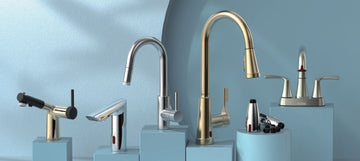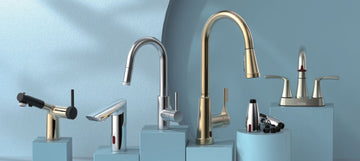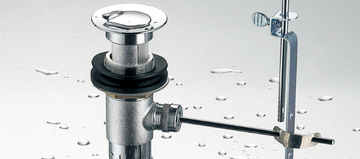Choosing a faucet can sometimes seem like a Herculean task with a multitude of considerations to take into account, from varying styles to specific features. But don't worry, you are not alone in this adventure. This comprehensive guide is designed to walk you through each step, demystifying the process and helping you make informed decisions. Get ready to discover how every detail, no matter how small, helps make your faucet not just a functional accessory, but a centerpiece of your space.
Here are the 9 points to absolutely take into account when choosing your faucet:
1. Understand the space needs:
- Analyze usage: Start by assessing the primary function of the space. For example, a kitchen may require a faucet with a pull-out spray to make washing vegetables easier, while a bathroom may require a more aesthetically pleasing faucet.
- Height and Reach: Find the ideal faucet spout height based on the size of the sink or tub. Adequate height ensures comfortable access to water, and the reach should match the size of the sink.
2. Style and aesthetics:
- Harmonization with Design: Today, the faucet is used in home decoration, mainly in the bathroom, sink and kitchen. The choice of faucet is made according to the style of the basin and the use of the space. We must therefore consider the general style of the room. The faucets can be contemporary, traditional, industrial, etc. Opt for a style that complements the overall design, ensuring aesthetic consistency.
- Look at the appearance: Faucets should be shiny, bubble-free, blemish-free and scratch-free, which is a quality standard. Imported faucets have more than 10 microns of plating, the purpose is to prevent rust, beautiful, to ensure that the use period.
3. Mounting Type:
- Sink or Wall: If the space is a kitchen, the usual choice is a sink-mounted faucet. For bathtubs, wall-mounted faucets are also popular. Adapt each type according to the configuration of the room.
4. Materials used:
- Durability: The steel ball valve is strong and durable, withstands pressure well, the sealing role of the rubber ring is easy to wear and tear, easy to age. The ceramic valve has good sealing performance, feels more comfortable and smooth.
- Test the water: Most faucets available on the market have a bubbler system, which ensures that the water is smooth and there are no excessive splashes, but also save water effectively. So you can place the faucet on the water pipe, try to see the water situation and then decide whether to buy the faucet or not.
- The quality of the faucet: A good faucet is not light, you can hold it in the palm of your hand to weigh it, there is a certain weight for a better quality faucet, and conversely a lighter faucet has strong chances of being made with inferior materials.
5. Handle Options:
- Single or Dual Controls: Single-handle faucets provide easier operation, while two-handle faucets provide more precise temperature control. It depends on personal preference.
- Turn the Handle: When purchasing a faucet, you can turn the handle to try to open and close the faucet smoothly. If there is an obvious case of blockage, it is not recommended to buy the faucet, indicating that the internal friction, of course, is too smooth, making it easy to slide.
6. Special Features:
- Motion sensor faucets: They have the benefits of increased hygiene and water saving. They can be especially useful in the kitchen to avoid touching the handles with dirty hands.
7. Industry Standards:
- Certifications: It is important to look for faucets that meet industry standards. Certifications may include quality standards, ecological standards, etc.
8. Ease of Installation:
- Personal or professional installation: There is potential complexity in installing the faucet. Faucets with simpler configurations can be installed easily on your own, but complex installations may require professional help.
9. Budget:
- Value for money: It is imperative to set your budget carefully and highlight the value for money of the products before making a purchase.

What are the types of faucets?
1. According to the material, SUS304 stainless steel, cast iron, integral plastic, brass, zinc alloy faucet, polymer composite material faucet and other categories are distinguished.
2. Depending on the function, basin, bathtub, shower and kitchen sink faucets are distinguished.
3. Depending on the structure, single, double and triple taps are distinguished. Additionally, there are single handles and double handles. The single faucet can be connected to the cold water pipe or the hot water pipe; the double faucet can be connected to both hot and cold water pipes, especially for bathroom sink and kitchen sink hot water supply; the triple faucet, in addition to the two pipes of hot and cold water, can also be connected to the shower head, and is mainly used for the bathtub faucet. The single-handle faucet allows you to adjust the temperature of hot and cold water, while the two-handle faucet requires adjusting the cold water hose and hot water hose to adjust the temperature some water.
4. According to the opening method, spiral handle, key handle, lifting handle and induction handle can be distinguished. To open the spiral handle, many rotations are required; the key handle usually only needs to rotate 90 degrees; the lifting handle only needs to be lifted to the water; the induction faucet is automatically taken out of the water as long as the hand is under the faucet. In addition, the faucet has a shut-off delay, the water flows for a few seconds before stopping, so that when the faucet is closed, the hands on the dirt can be rinsed again.
5. According to the points of the coil, rubber core (slow opening coil), ceramic coil (quick opening coil) and stainless steel coil, etc. can be distinguished. The most critical impact on faucet quality is the spool. Rubber slide valves are mainly cast iron valves with spiral opening, which have been virtually eliminated; ceramic drawer faucets have appeared in recent years, their quality is better and they are now more common; Stainless steel slide faucets have only recently appeared, they are more suitable for areas with poor water quality.
Conclusion :
As you've discovered, every choice, from mounting type to material durability, influences the daily experience in your space. Choosing the right faucet is a challenge, but it is also an opportunity to express your unique style and create an environment that is uniquely yours. We hope this guide has brought clarity and understanding to this sometimes confusing process. At TODOT, we are here to simplify this journey, so that every user can make an informed choice and find the perfect faucet that meets their needs. Thank you for joining us on this fascinating exploration, and may every drop of your new faucet bring comfort and elegance to your daily life.




